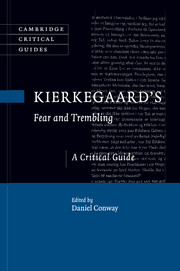Book contents
- Frontmatter
- Contents
- List of Contributors
- Acknowledgments
- List of Abbreviations
- Introduction
- Chapter 1 Homing in on Fear and Trembling
- Chapter 2 Fear and Trembling’s “Attunement” as midrash
- Chapter 3 Johannes de silentio’s dilemma
- Chapter 4 Can an admirer of silentio’s Abraham consistently believe that child sacrifice is forbidden?
- Chapter 5 Eschatological faith and repetition: Kierkegaard’s Abraham and Job
- Chapter 6 The existential dimension of faith
- Chapter 7 Learning to hope: the role of hope in Fear and Trembling
- Chapter 8 On being moved and hearing voices: passion and religious experience in Fear and Trembling
- Chapter 9 Birth, love, and hybridity: Fear and Trembling and the Symposium
- Chapter 10 Narrative unity and the moment of crisis in Fear and Trembling
- Chapter 11 Particularity and ethical attunement: situating Problema III
- Chapter 12 ‘He speaks in tongues’: hearing the truth of Abraham’s words of faith
- Chapter 13 Why Moriah?: weaning and the trauma of transcendence in Kierkegaard’s Fear and Trembling
- Bibliography
- Index
Chapter 7 - Learning to hope: the role of hope in Fear and Trembling
Published online by Cambridge University Press: 05 February 2015
- Frontmatter
- Contents
- List of Contributors
- Acknowledgments
- List of Abbreviations
- Introduction
- Chapter 1 Homing in on Fear and Trembling
- Chapter 2 Fear and Trembling’s “Attunement” as midrash
- Chapter 3 Johannes de silentio’s dilemma
- Chapter 4 Can an admirer of silentio’s Abraham consistently believe that child sacrifice is forbidden?
- Chapter 5 Eschatological faith and repetition: Kierkegaard’s Abraham and Job
- Chapter 6 The existential dimension of faith
- Chapter 7 Learning to hope: the role of hope in Fear and Trembling
- Chapter 8 On being moved and hearing voices: passion and religious experience in Fear and Trembling
- Chapter 9 Birth, love, and hybridity: Fear and Trembling and the Symposium
- Chapter 10 Narrative unity and the moment of crisis in Fear and Trembling
- Chapter 11 Particularity and ethical attunement: situating Problema III
- Chapter 12 ‘He speaks in tongues’: hearing the truth of Abraham’s words of faith
- Chapter 13 Why Moriah?: weaning and the trauma of transcendence in Kierkegaard’s Fear and Trembling
- Bibliography
- Index
Summary
Introduction
Kierkegaard’s work contains rich discussions of several virtue terms: faith; courage; trust; patience; gratitude; humility; hope. Several recent interpretations of Fear and Trembling have connected Abraham’s faith with some such related terms; for instance, a series of recent articles by John J. Davenport has treated faith as “eschatological trust,” while Clare Carlisle places courage center stage. I find myself increasingly attracted to the “faith as eschatological trust” reading. My purpose here is to try to complement Davenport’s account, by putting more emphasis than is typical on the role of hope in Abraham’s faith. (Although it plays a significant role in the eschatological trust interpretation, Davenport does not discuss hope in detail.) I aim to flesh this out by reading Fear and Trembling against the background of the 1843 discourse “The expectancy of faith,” one of the discourses in which – as both Robert C. Roberts and William McDonald have noted – Kierkegaard discusses the concept of hope in most detail. Then, after a brief outline of the “eschatological trust” reading of Fear and Trembling, I will discuss two possible objections thereto, arising from “The expectancy of faith.” Both, I will suggest, can be resisted. The second can be addressed by comparing Abraham’s hope with the “radical hope” discussed by Jonathan Lear in his book of that title. This reading will, I hope(!), clarify, in more detail than hitherto, the importance of hope in existential faith. It will also throw some light on what Johannes de silentio calls “the courage of faith,” and why he describes that courage as “humble.”
Hope does not exactly leap off the page as an important theme in Fear and Trembling, and at one point Johannes contrasts faith with a “paltry [usle] hope” (FT 30/SKS 4, 132). The hope that plays a key role in Abraham’s faith must be hope of a particular kind. I shall argue that it is akin to what Kierkegaard in the discourses calls “expectancy” [Forventning].
- Type
- Chapter
- Information
- Kierkegaard's Fear and TremblingA Critical Guide, pp. 122 - 141Publisher: Cambridge University PressPrint publication year: 2015
- 4
- Cited by



